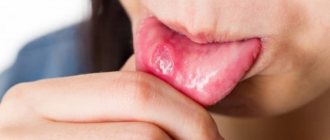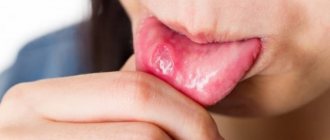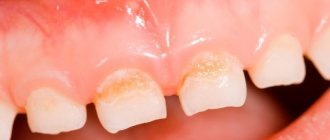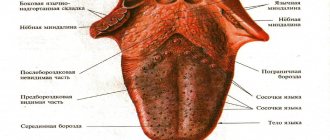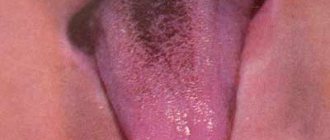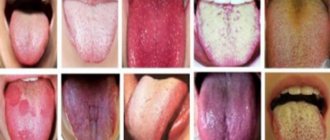If bubbles appear on your child's tongue , do not try to get rid of them yourself. Surely there were reasons for their occurrence, and only a specialist can accurately determine them. First, the doctor must find out what exactly triggered the formation of painful blisters on the child’s tongue. The reasons vary. Most often, white blisters appear due to a fungal infection or thrush. Also, their occurrence could be detected by severe dysbiosis or as an allergy. It should be noted that most allergic reactions manifest themselves in the form of urticaria, diathesis or dermatitis.
Causes of bubbles on a child’s tongue
In order to help the child as quickly as possible and prescribe appropriate treatment, it is necessary to determine the causes of the formation of bubbles on the child’s tongue. The very first reason why the mucous surface of a child’s tongue becomes covered with pimples is thrush. Often, this disease affects young children whose immunity is severely weakened. Small white bubbles form not only on the surface of the tongue, but throughout the entire oral cavity.
Treatment consists of frequent wiping of the mouth with a tetraborate solution, which contains glycerin. Sometimes doctors prescribe glycerin-based borax. All these drugs are easily available and are available even without a doctor's prescription. Therapy is carried out as follows. Take a piece of clean bandage and wrap it around your index finger, then moisten it generously in the liquid and gently wipe your tongue, and then your entire mouth. Try not to press on the tongue as this may trigger the baby's gag reflex. A similar treatment of the oral cavity should be carried out after each meal.
What is this disease?
Herpetic stomatitis is a pathological process that develops in the mucous membrane lining the oral cavity. The causative agent of this disease is herpes simplex virus type 1. In children under the age of five, this virus is detected in 60% of all cases. By adolescence, it is detected in the vast majority of people. Herpes stomatitis in children develops during the baby’s first contact with the virus. This occurs most often before the age of three.
The high incidence is explained by:
- low level of production of own antibodies;
- immaturity of cellular immunity;
- the fact that the baby does not receive antibodies from mother's milk;
- high reactivity of the child's body.
If the baby is bottle-fed, he may get sick in the first months of life. Viral infection often goes into a latent state. It persists in the nerve ganglia.
Another reason for the formation of pimples on a baby’s tongue is dysbacteriosis.
With dysbacteriosis, pimples cover the mucous membrane of the child’s tongue and externally resemble small ulcers. Treatment should be started immediately, since such bubbles cause severe pain.
In cases where pimples turn into ulcers, you should pay attention to the condition of the child’s intestines. After all, it is possible that exactly the same ulcers appear there as on the surface of the tongue. Therefore, if you notice even small pimples on a child’s tongue, you should undergo an examination of the whole body. This will allow us to determine the causes of this phenomenon and begin appropriate treatment.
Clinical manifestations
Stomatitis in children is characterized by a gradual onset of the disease. Clinical signs of the disease do not appear immediately after infection. The incubation period is typical for this pathology; it lasts from two days to three weeks.
Symptoms of herpetic stomatitis in children appear starting from the prodromal period.
Each period has its own clinic:
- Latent – lasts up to two weeks. The child's sleep is disturbed and he refuses to eat. The baby becomes restless and whiny. He has increased salivation, possible nausea and vomiting. The lymph nodes are enlarged and painful on palpation.
- The height of the disease - at this time rashes appear on the skin and mucous membranes. They are located on the soft, hard palate, gums, cheeks, lips and tongue. They are group or single, up to three millimeters in size. They are thin-walled bubbles filled with a clear liquid. Their formation lasts up to four days. The vesicles quickly open, then erosions and painful aphthae form. They are shallow ulcers covered with a white coating. The mucous membrane in the mouth is swollen and bleeding. The child develops a high temperature of up to 40 degrees. A runny nose, cough, and conjunctivitis occur.
- Fading - aphthae, erosions gradually heal and epithelialize. These formations heal without scarring. Often there is a wavy course of the disease. The periods of appearance of rashes alternate with rises in temperature.
The illness usually lasts up to two weeks. In children under one year of age, generalization of the process is possible. The development of sepsis, damage to all internal organs and meninges is likely.
To cure blisters on a child's tongue
In order to eliminate bubbles on a child’s tongue that have formed due to dysbiosis, it is first necessary to undergo treatment aimed at restoring full intestinal functions. If this is a small child, then first you need to deal with nutrition. For example, you can add white cabbage to the cutlets, previously minced through a meat grinder. Cabbage plays the role of a “broom” and removes all harmful elements from the children’s intestines.
If we are talking about the digestion process of infants, then the mother should reconsider her diet. Treatment of blisters can be carried out only after consultation with a doctor. The specialist will select the drug that will not harm the baby.
Prevention
Preventive measures are aimed at preventing infection. This presents certain difficulties, since the vast majority of the population is infected with it. It is better if the child gets sick from it at an older age.
For this it is recommended:
- avoid contact with infected people;
- will provide personal utensils and personal hygiene products for the child;
- Kissing people with herpetic rashes is prohibited;
- strengthening the baby's immune system.
It is recommended that the child be provided with adequate nutrition and regularly given vitamin and mineral complexes.
Quite often, children develop pimples on their tongues caused by an allergic reaction of the body.
If there is an allergy, the child's tongue becomes covered exclusively with white blisters. This is their main feature. First, you need to exclude foods that could cause allergies from your diet. You will also temporarily have to give up scented soaps, powders and other detergents of synthetic origin. Believe me, regular baby soap or laundry soap will be much more beneficial in this case. Try to wet clean your home and remove dust more often. It is recommended to treat blisters on the tongue of infants with a regular soda solution.
Dear mothers, do not forget that only a qualified specialist can accurately determine the cause of bubbles on the child’s tongue and prescribe the necessary course of treatment.
Do not self-medicate at home, because the most valuable thing is at stake, namely the health of your baby! The main reasons for the formation of bubbles on a child’s tongue
Preventive measures to help avoid the appearance of pimples on a child’s tongue
To avoid the appearance of such not very pleasant manifestations in a child, you should teach him to follow the following rules:
- Keep your mouth clean.
- Do not chew foreign objects.
- Visit your dentist regularly
- Eat only foods that do not irritate the mucous membranes.
- At the first sign of infection, consult a doctor.
- Strengthen your immune system by consuming the maximum amount of seasonal vegetables and fruits.
- Take the necessary vitamins according to your age
You need to monitor your child's tongue - this is an indicator of the condition of the internal organs.
Make it a habit to monitor the condition of your baby's tongue. Teach him from childhood to monitor his health and adhere to basic hygiene rules.
Reasons for appearance
There are many reasons why a child may develop such formations. Let's look at each of them in more detail.
Traumatic damage to the tongue
After 3 months, children begin to actively explore everything that surrounds them and taste everything. But objects that enter the baby’s mouth are not always sterile. Older children often chew on sharp objects that can easily cut or scratch their tongue. Even with minor trauma to the mucous membranes, microbes can enter them, and as a result, an inflammatory process develops and painful pimples appear, most often localized on the tip of the tongue.
Oral candidiasis or thrush
Babies under 1 year of age do not have a sufficiently developed immune system, so after any illness the body’s protective properties are reduced. As a result, active growth of Candida fungi occurs on the mucous membranes and oral candidiasis occurs.
Taking antibiotics also contributes to this. One of the typical symptoms of thrush is the appearance of pimples and a white cheesy coating on the entire surface of the tongue; they may also spread throughout the entire oral cavity. After removing such plaque, you can see swelling, redness and even small ulcers underneath.
Stomatitis
Stomatitis is manifested by the presence on the tongue (its root, tip, side surfaces) of small, painful white pimples that cause discomfort when speaking and while eating. If these pimples coalesce, large ulcers can form. In severe cases of the disease, the baby’s body temperature rises and general well-being is disturbed.
Allergic reactions
Children under two years of age are much more likely than adults to experience allergies. One of its manifestations is the appearance of small red or white pimples on the tongue. They can be found both at the root and at the tip of the tongue. Such pimples tend to spread to the palate, gums, lips and other parts of the oral mucosa. Such formations most often cause anxiety to the baby, cause pain when eating, swallowing, and itching. But body temperature remains within normal limits.
Allergy symptoms intensify and new pimples appear due to the use of a product to which you are hypersensitive. Often, such allergic reactions can be caused by the use of toothpaste or other oral care products, even if they are recommended for use by children.
Angina
A bacterial infection that affects the tonsils in childhood can also spread to the lymphoid tissue located closer to the throat, at the root of the tongue. In this case, white pimples with a purulent coating appear in the tongue area. If the pus is removed, you may see exposed areas with minor swelling and redness. Such formations are painful, they interfere with normal swallowing and worsen the overall well-being of the baby: he refuses to eat, is capricious, and the body temperature may be elevated. In the presence of such pimples, it is often possible to detect enlarged lymph nodes near the throat.
Herpetic infection
In childhood, it is very easy to become infected with the herpes virus. The infection worsens as a result of a decrease in the body's immune defense. Small watery pimples on a red background appear on the tongue. They can also be found on a child's lips or throat. They are characterized by severe pain, and after they burst, such pimples leave shallow ulcers that prevent the baby from speaking and eating normally.
Unbalanced diet and intestinal dysbiosis
If there are errors in the nutrition of children, especially young children, if the composition of the normal intestinal microflora is disrupted, glossitis can develop - inflammation of the mucous membrane of the tongue. As a result of this, active division of the epithelium of the papillae occurs and they look like inflamed whitish6 or red pimples. They rarely cause concern to the child; sometimes sensitivity to cold, sour or hot food changes slightly.
Causes of herpangina
Herpangina can be caused by about 70 serotypes of enteroviruses. Most often these are Coxsackie B, Coxsackie A17 viruses and enterovirus 711.
Since the only carrier of enteroviruses is humans, you can become infected through contact with a sick person or with a virus carrier who has no symptoms of the disease1. According to the literature, the number of virus carriers can be up to 46% of people2.
The virus is released into the external environment with feces and droplets of saliva. It is also contained in bubbles that appear in the patient’s throat. Enterovirus infections most often affect children, although the disease also occurs in adults5.
The patient or virus carrier excretes viruses from the upper respiratory tract within 3 weeks after infection, and with feces - up to 8 weeks. In the first two weeks, herpetic sore throat is most contagious1.
You can become infected in the following ways:
- through dirty hands, objects and food if they are exposed to the virus;
- drinking contaminated water from a reservoir;
- upon contact with a patient or virus carrier.
The herpangina virus is also transmitted transplacentally - from mother to fetus3.
Up to contents
Treatment options
If you know the cause of acne formation, then you can carry out symptomatic treatment aimed at eliminating them. When the appearance of formations is caused by a sore throat, antibacterial drugs are prescribed. Candidiasis is treated with antifungal agents, herpes with antiviral agents, and allergies with antihistamines. It is important that treatment is prescribed by a doctor; taking it on your own can worsen the condition and cause a lot of problems.
During therapy, it is important to follow recommendations regarding nutrition and oral hygiene. If you have a painful symptom, you should exclude hot drinks and dishes, spicy, salty and sweet foods from your diet. If pimples on the tongue are closer to the tip, then you should not chew seeds and nuts, or eat hard foods, which can further injure the mucous membrane. It is important to stop drinking alcoholic beverages and nicotine. Also, after any meal, it is recommended to thoroughly rinse your mouth to remove food debris, which can be an excellent breeding ground for bacteria.
To relieve inflammation and relieve discomfort, you can rinse several times a day with an infusion of herbs such as chamomile, calendula, sage, and sea buckthorn. A good disinfectant is a soda solution, which is especially important for candidiasis. The inflammatory process can also be stopped by sucking bee nectar or honey.
Symptoms of herpetic sore throat
The disease begins acutely. From the moment of infection to the first symptoms, it takes from 2 to 14 days3. The temperature rises to 38-39°C. The patient feels weakness, headache, chills, less often nausea, possible vomiting and enlargement of the submandibular lymph nodes, 1,2,3.
Herpangina goes through several stages2:
- The day before the rash appears in the throat, the patient feels a mild pain. On examination, you may notice redness of the palatine arches and the back wall of the pharynx.
- Then, rashes appear on the mucous membrane of the soft palate, palatine arches, tonsils and uvula - small papules (nodules) up to 5 mm in diameter with a red rim.
- The nodules turn into vesicles, which open after 1-2 days.
- In their place, painful erosions with a gray-white coating form.
Up to contents
Course of herpetic sore throat
The diagnosis of herpetic sore throat can be made by an otolaryngologist, therapist or pediatrician after examining the patient and clarifying his complaints. To monitor changes characteristic of a viral infection, the doctor may prescribe a general blood test, and to confirm enteroviral sore throat, a specialist may prescribe a pharyngeal smear and a blood test for specific antibodies. The pathogen can also be detected in stool or inflammatory fluid that is released from vesicles1,4.
Manifestations of herpetic sore throat can go away on their own in less than 10 days. But in any case, at the first symptoms of the disease, you should definitely consult a doctor. You cannot self-medicate2,3.
In some cases, herpetic sore throat can cause complications from the nervous system. In this case, 1 appears:
- severe spasm of the neck muscles, due to which the child cannot bend his head;
- weakness of the muscles of the limbs;
- disturbance of consciousness.
A severe complication of herpetic sore throat is damage to the soft membranes of the brain, brain and spinal cord1,3.
Newborns are at highest risk of developing complications, so they need careful treatment and care3. It is important to maintain hydration and give your child enough fluids1.
Up to contents
